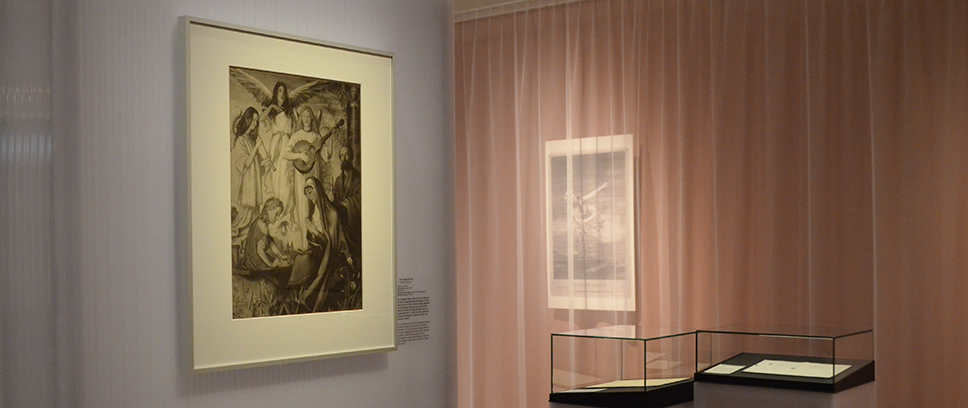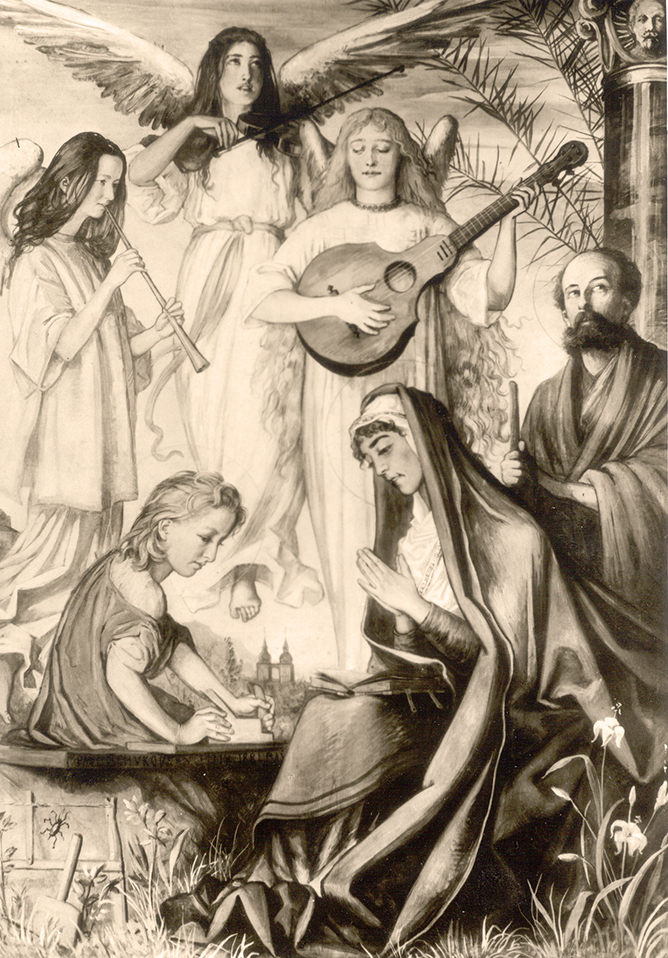
What’s that for? The painting “The Holy Family” by Paul von Joukowsky
Sven Friedrich | 4 May 2022
England has the Windsors – Germany the Wagners: Richard Wagner and his descendants have always met with especial veneration. A particular example of this is the painting “The Holy Family” by Paul von Joukowsky from the year 1881, which can currently be seen on loan in the exhibition “Richard Wagner and the Nationalization of Feeling”. Sven Friedrich, director of the Richard Wagner Museum, from whose collection the painting comes, describes the idolising mythification of the Wagner family.
The monumental realisation of Richard Wagner’s music dramas in the theatrical temple of the Bayreuth Festspielhaus – reserved exclusively for these operas – seems almost like a mirror image of the egomaniacal character of the “Master”. In any case, Wagner, the “snuffling gnome from Saxony with his colossal talent and shabby personality” (Thomas Mann), greatly appreciated the appellation “Master”. The hypertrophic aesthetics of Wagner’s “Gesamtkunstwerk” would prove in many ways to lend itself to emulation as a kind of metapolitics, but also in its worldview and ideology.
Particularly after his death in 1883 and largely promoted by his widow Cosima, the daughter of Franz Liszt, there arose a mythification of Wagner, like few other artists have ever experienced. As a veritable sect-like cult religion, this “Wagnerianism” was centred in Wagner’s Bayreuth residence “Wahnfried” – now the Richard Wagner Museum – and found its ideological foundation in the so-called “Bayreuth Circle” around its “chief ideologist” Houston Stewart Chamberlain, who raised Wagner’s artistic and cultural conception with its antisemitic, racist and parareligious elements to a political ideology.
After Wagner died without leaving a testament, Cosima Wagner saw herself as the natural custodian of his legacy and subordinated everything to the “Master”, his works, and his family. By designating their son Siegfried as sole heir, she founded the Wagner dynasty, which was accorded a similarly adulatory veneration by the “Wagnerians” as that bestowed only on royal families. And thus the cult of Wagner, his oeuvre and his descendants sometimes took on downright grotesque manifestations.
A particular example of the glorification of the Wagner family is the embarrassingly kitschy representation of them as the “Holy Family” by Paul von Joukowsky from the year 1881. What looks like irony today was unfortunately taken quite seriously at the time. The 12-year-old Siegfried is actually portrayed as a carpentering boyhood Jesus figure at the feet of his sisters Eva, Isolde and Blandine, depicted as music-making angels, while the painter accords the role of the adoring mother Mary to the eldest half-sister Daniela von Bülow and that of the heavenwards gazing Joseph to himself. In the background one can make out the towers of the Bayreuth City Church, while a pillar in the righthand corner of the picture is crowned almost inconspicuously and yet revealingly by a medallion with the face of Count Arthur de Gobineau, Richard Wagner’s crown witness for racial theory… A year later, Joukowsky was to design the scenery for Wagner’s Christianly arrayed “consecrated festival stage play” Parsifal.

In 1914 the festival and the family found themselves in the public line of fire when rumours of “god-son” Siegfried’s homosexuality began to be corroborated, and Isolde, the eldest daughter of Richard and Cosima Wagner, who was legally still listed as the daughter of Cosima’s first husband Hans von Bülow, filed suit against her mother to have her recognise the paternity of Richard Wagner, with which Eva aimed to assure in particular the hereditary claims of her son. However, the disconcerting matters surrounding the “Wahnfried Clan” soon disappeared from the scrutiny of the public due to the outbreak of the First World War.
The following generation was marked above all by Winifried Wagner, the wife of Siegfried Wagner, particularly after Siegfried’s death in 1930. Winifried Wagner had been a close friend of the Wagnerian Adolf Hitler since 1923, and after Hitler’s “seizure of power” in 1933, the festivals became the royal theatre of the “Führer” and the four children Wieland, Friedelind, Wolfgang and Verena the unofficial princes and princesses of the Third Reich, as it were.
Although the Bayreuth Festival is now an institution under public law and an influence of “the family” almost no longer exists, the direction of the festival is legitimised above all through the in itself ideologically dubious “bloodline” carried down to Richard Wagner’s great-granddaughter Katharina and through a disproportionately keen public interest in the descendants of the Bayreuth “Master”.
 © Foto: Andrea Forster, Bayreuth |
Dr Sven FriedrichAfter completing his Abitur and training as a bank clerk, Sven Friedrich (*1963) studied theatre, modern German literature and communications at the Ludwig Maximilian University of Munich, where he earned his doctorate in 1994 with a dissertation on Richard Wagner’s theatrical aesthetics. Since 1993 he has been director of the Richard Wagner Museum, Haus Wahnfried, with the National Archives and Research Centre of the Richard Wagner Foundation Bayreuth, as well as head of the Jean Paul and Franz Liszt Museums of the city of Bayreuth. |